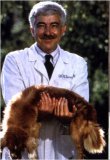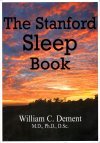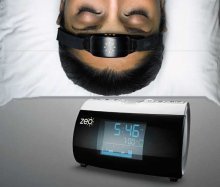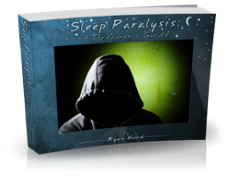
| Connect & Subscribe |
Narcolepsy Symptoms Explored
Written by Elizabeth Lake with contributions from Kevin Morton and the Stanford Sleep Book, Winter 2010Over 250,000 Americans live with narcolepsy and the often frustrating symptoms that come along with it. Although narcolepsy occurs in a broad scale of degrees of severity, it has some of the most telltale symptoms of any condition known to man. Before we delve into them though, let's first make sure it is clear what narcolepsy is.
Narcolepsy is a sleep disorder characterized by unremitting tiredness, excessive daytime sleepiness, and pathological manifestations of REM sleep, including the dream-like hallucinations and paralysis characteristic of this stage of sleep, experienced both in the form of cataplectic attacks and sleep onset REM periods.
People generally start experiencing the symptoms of narcolepsy in adolescence, although later onset is possible. Although there is no known cure for narcolepsy today, diagnosis is important since management of narcolepsy symptoms can greatly improve an individual's quality of life. And to understand the diagnosis process, you must understand the symptoms themselves, which are outlined below.
Dr. D's Sleep Book Says...
A capsule description of narcolepsy is that the victims are:(a) sleepy all the time, day after day, month after month, year after year, and (b) have episodic attacks of muscle paralysis (cataplexy) typically triggered by strong emotion.
We'll take a more in depth look below at those two main narcolepsy symptoms--cataplexy and excessive daytime sleepiness--as well as two other auxiliary symptoms of narcolepsy--sleep paralysis and hypnagogic hallucinations.
Cataplexy
The defining characteristic symptom of narcolepsy is cataplexy. A person having a cataplectic attack will experience sensations due to REM sleep paralysis ranging from brief weakness in isolated muscle groups (which often gives rise to sagging feelings, such as the head dropping or the knees weakening) to a complete postural collapse to the ground and inability to move.
The following is a video that portrays the complete cataplectic collapse in a human with narcolepsy, followed by a series of clips of narcoleptic dogs experiencing various ranges of cataplectic attacks.
Dr. Dement, our teacher, is among the world's foremost experts on narcolepsy and often remarks that cataplexy has to be just about the most blatantly telling symptom of any condition known to man. After watching the video above you can likely understand what he means.
The most amazing and mysterious aspect of cataplexy is the way the attacks are triggered--mostly by instances of strong emotion. Eruptive bouts of laughter, anger, or exhilaration are typical precursors. Or, as portrayed in the video, for cataplectic dogs their episodes commonly are triggered by the excitement of eating.
Episodes of cataplexy generally are a few seconds to several minutes in duration.
Consciousness and perception are usually maintained and clear during brief cataplectic episodes of a few seconds to a minute. If attacks of cataplexy last more than a minute they can transition smoothly into complete REM sleep, in which the patient will experience hallucinations or even dreams, which leads us to another narcolepsy symptom that we will discuss in a bit.
Dr. D's Sleep Book Says...
The involvement of REM sleep processes in narcolepsy was first demonstrated in 1960 when a REM sleep abnormality, the sleep onset REM period (going straight into REM sleep upon falling asleep), was described in narcoleptic patients. This discovery led directly to the important realization that cataplexy, hypnagogic hallucinations, and sleep paralysis are manifestations of REM sleep processes occuring in an abnormal manner.
Excessive Daytime Sleepiness (EDS)
Perhaps the most troublesomeof the symptoms of narcolepsy is the constant feeling of sleepiness that can really be both disabling and dangerous when it comes to everyday life for a person with narcolepsy.
Even though sleepiness can be temporarily offset by activity, it quickly returns after stimulation is terminated. Narcoleptics can fall asleep in highly unusual situations, such as while eating a meal or talking to a friend, circumstances that cannot be dismissed as resulting from just normal sleepiness.
Driving is also a major problem for someone who has untreated narcolepsy, and if the ability to stay alert while driving is threatened the sleepiness is immediately life threatening and cannot be ignored. Learn more about driving and narcolepsy.
Sleepiness is usually the first symptom of the narcoleptic tetrad to appear. As such, attributing the sleepiness to anything that makes sense at the time can often be a rather perplexing challenge for an undiagnosed narcoleptic, until an episode of cataplexy prompts a visit to the sleep doctor and the persistent tiredness makes sense as a symptom of narcolepsy.
But one doesn't have to wait until cataplexy emerges to seek treatment. If you are persistently tired day after day, do not hesitate to seek the assistance of a sleep specialist, and in the meantime do not drive or participate in other potentially dangerous activities that could be compromised by your lack of alertness.
Sleep Paralysis and Hypnagogic Hallucinations
Sleep paralysis and hypnagocic hallucinations are auxiliary narcolepsy symptoms, seen separately or in combination in about half of all patients.
Sleep paralysis occurs when an individual is unable to move for a minute or so while entering sleep or while waking up from sleep, and is a product of the REM atonia that keeps our bodies from moving while we dream.
It isn't uncommon for individuals without narcolepsy to experience sleep paralysis if they wake up in the middle of a REM sleep cycle. But since all narcoleptics have sleep onset REM periods, where they fall asleep straight into REM sleep as opposed to the usual NREM, sleep paralysis at the start of a sleep episode is strictly characteristic of narcolepsy.
Learn more about sleep paralysis and why it happens.
Hypnagogic hallucinations are vivid, perceptual, dreamlike experiences occuring at sleep onset, often accompanied by fear or dread at what is being perceived.
Like sleep paralysis, hypnagogic hallucinations also appear occasionally in people who do not have narcolepsy. But the nature of the abnormal REM processes of narcolepsy makes them a pretty common feature in narcoleptics.
Learn more about hypnagogic hallucinations.
Narcolepsy Symptoms Checklist:
- Are you constantly drowsy, no matter how much sleep you get?
- Have you ever unexpectedly fallen asleep in unusual circumstances?
- Do you experience muscle weakness or even paralysis, especially when excited or emotional?
- Are these symptoms accompanied by hallucinatory images?
If you answered "yes" to any of the above questions, please visit a sleep disorders clinic and go through a simple exam to determine if narcolepsy treatment options are available for you. Again, although there are no known "cures" for narcolepsy, there are medications available to minimize its effects and to greatly improve your quality of life.
And join the conversation with your own comments here:
blog comments powered by DisqusAbout This Site
Welcome! This site is continuously being created by students of Dr. William C. Dement's Sleep And Dreams course at Stanford University.
We made this site as a call to action for people all over the world to live healthier, happier, safer, and more productive lives by learning about their own sleep. We have faith that reading the information provided on this site will motivate you to be smart about your sleep deprivation and strategic about your alertness in order to live life to your fullest, most energetic potential.
In fact, we challenge you to do so! What do you say, are you up for the challenge?
Interviews With Sleep Specialists: Insights Into the Worlds of Sleep Medicine & Sleep Business
America's Most Dangerous Disorder: What Is Sleep Apnea Doing To Your Sleep?
Sleep Debt: How Much More Will You Achieve When You Reduce Yours?
The Stages Of Sleep: The Journey Through The Night
Delayed Sleep Phase: You Want To Sleep But You're Not Tired Yet
Paralyzed at Night: Is Sleep Paralysis Normal?
Sleep In Words: Smart, Strange, and Funny Quotes About Sleep
Sleep Disorders In Children: What's Keeping Your Child From A Full Night's Rest?
Attacks of Pavor Nocturnus (a.k.a. Sleep Terrors, Night Terrors, or Incubus Attacks)
Learn More
The Stanford Sleep Book
Dr. Dement's pioneering textbook has been the core text for Sleep and Dreams since 1980, but it has just recently been made available to the wider public for the first time.
In it you'll find a more detailed account of the most important things you need to know about sleep, alertness, dreams, and sleep disorders. Studies, statistics, plus plenty of Dr. Dement's classic anecdotes painting the history of sleep medicine.
Preface | Intro | Contents | Get A Copy
More Sleep Resources
The Zeo
A revolution in personal sleep tracking, the Zeo is a wireless headband that transmits your brainwaves in realtime to a dock (pictured here) or your smartphone. The result? You can wake up and see exactly what stages of sleep you were in during the night! Unprecedented personalized sleep knowledge.
Sleep Paralysis: A Dreamer's Guide
Ever woken up paralyzed? A surprising number of us have, believe it or not. But few know the actual causes of this phenomenon, and fewer still how to exert control over it. Dream researcher and sleep paralysis expert Ryan Hurd shares breakthrough insights into how to do just that.
Important Disclaimer
Please Note:
The information found on this page and throughout this site is intended for general information purposes only. While it may prove useful and empowering, it is NOT intended as a substitute for the expertise and judgments of healthcare practitioners.
For more info, see our
Terms of Use.
How did we make this website?
Looks like magic, right?

You can learn how to make a great website too. Find out how!












